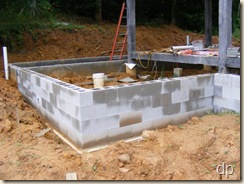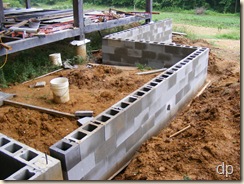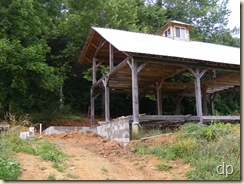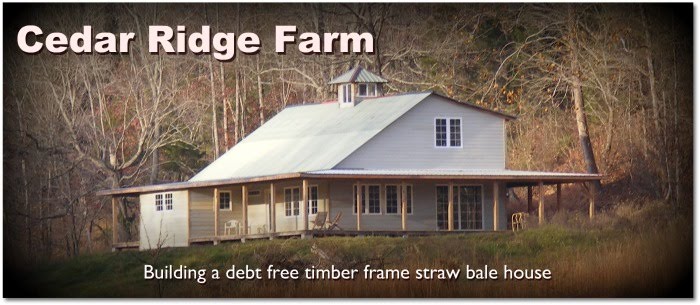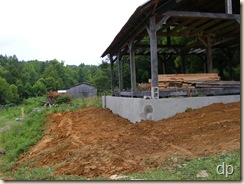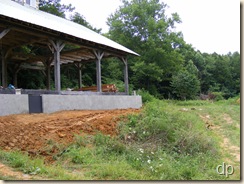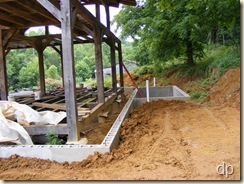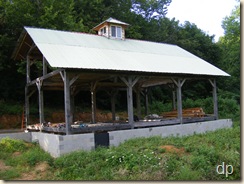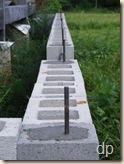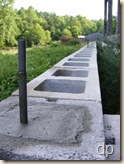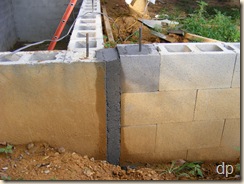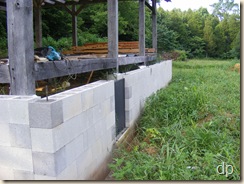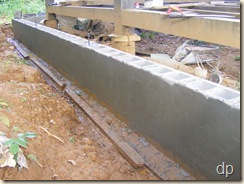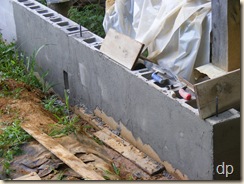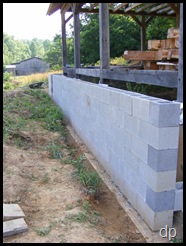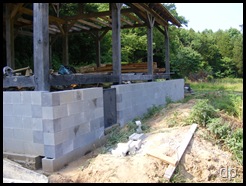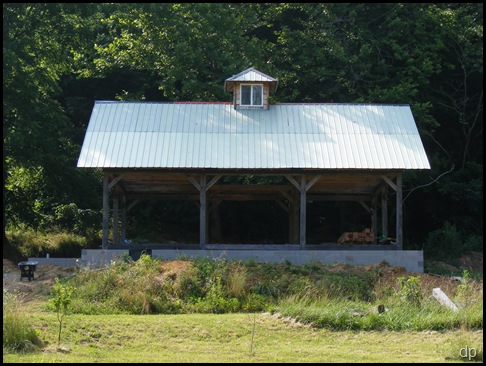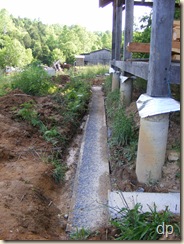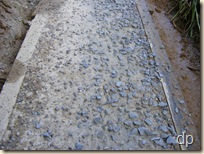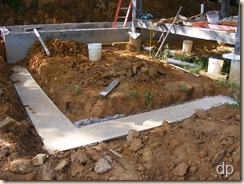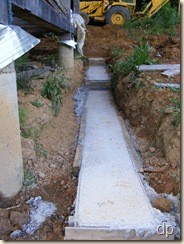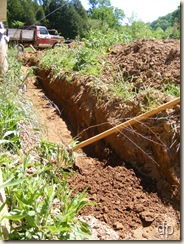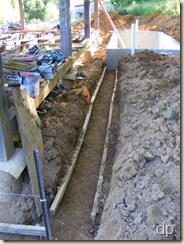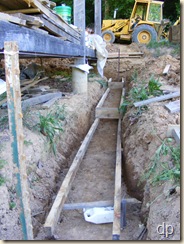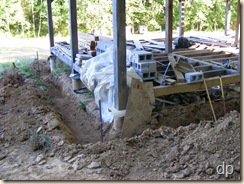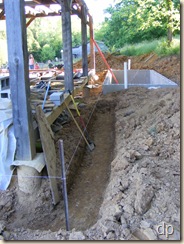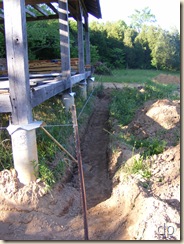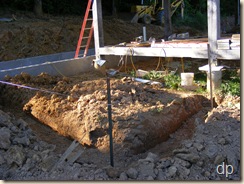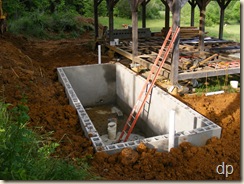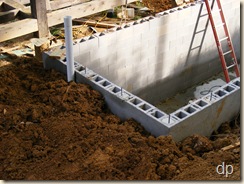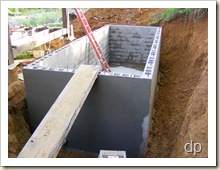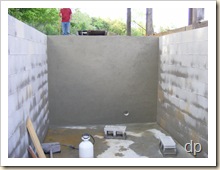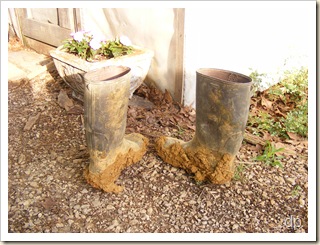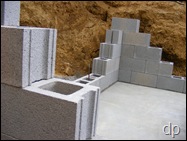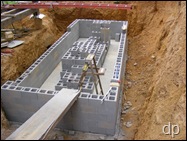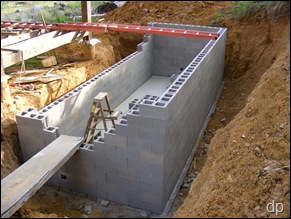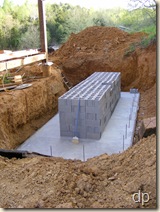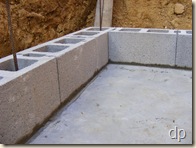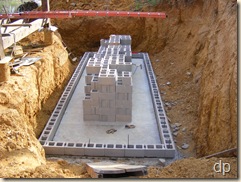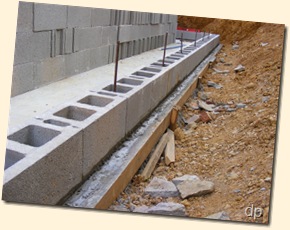We’ve had plenty of rain so far this year. The garden has not suffered from dryness. In between rain showers and storms and all the other work there is to be done around here, I have continued to work on the house. I laid out blocks on the footer last week, figuring where the crawlspace walls need to be in relation the house frame.
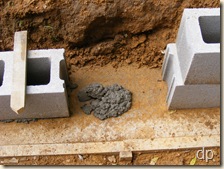 Earlier this week, after some rain and before some other rain, I started mortaring the first course of blocks on the west side of the house for the wall that will be under the mudroom. The first step in the process was to remove some of the accumulated mud that had been deposited around the blocks by the rain. Then, I lifted out the block that was to be mortared into place, and placed some mortar where the block had been.
Earlier this week, after some rain and before some other rain, I started mortaring the first course of blocks on the west side of the house for the wall that will be under the mudroom. The first step in the process was to remove some of the accumulated mud that had been deposited around the blocks by the rain. Then, I lifted out the block that was to be mortared into place, and placed some mortar where the block had been.
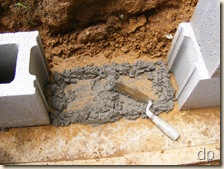 After distributing the mortar where the bottom edge of the block would set on it, I placed the block back into position. The main purpose for the mortar is to get the first course of blocks level. So, after placing the block on the mortar, I used a piece of wood to get it into place and then checked its placement with a level. I endeavored to make sure that each block was level side-to-side and along the line with the other blocks.
After distributing the mortar where the bottom edge of the block would set on it, I placed the block back into position. The main purpose for the mortar is to get the first course of blocks level. So, after placing the block on the mortar, I used a piece of wood to get it into place and then checked its placement with a level. I endeavored to make sure that each block was level side-to-side and along the line with the other blocks.
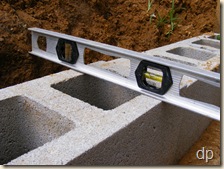
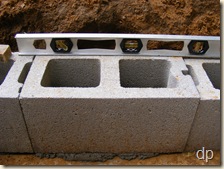
It takes a while to mortar the first course of blocks into place. I was able to complete the ones on the level that will be beneath the mudroom. It then rained off and on during the next couple of days, and I managed to work on some other things that needed done.
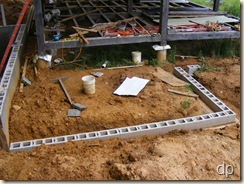
I was able to return to the project yesterday afternoon after spending the morning working on my class (I teach a class online for a university). I started by mortaring the blocks along the next level of the footer on the west side of the house. This is a shorter run than the previous level, and it went fairly quickly.
After getting these blocks mortared into level, I began laying blocks. One thing about dry stack concrete block construction is that the block-laying goes quickly. I had to haul the blocks from where I had the block company put them a few weeks ago which is maybe 20 yards away and down hill from the house. I moved six at a time using a wheel barrow. That seemed to work better than using a hand truck.
I began laying blocks for the walls under the mudroom since that mortar was fully set up and cured. After completing laying those, I went ahead and laid the ones on the section I had just mortared. I figured that the mortar wasn’t going to settle or move with the weight of the blocks anyway.
Because of the way I designed and poured the footer, there are four levels for the blocks around the house. I did not worry about making the steps for each level perfect with the other levels so that the blocks could 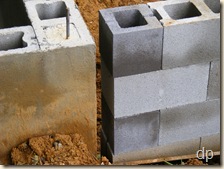 be laid seamlessly all the way around the house. Each level can be constructed as a separate wall. Any gaps that may exist between levels will be filled with concrete. Then, the whole thing will be coated with surface bonding cement. I will cut cedars for the sill on top of the wall, so any variation in height will be accounted for in the dimensions to which I cut them. This simplified the figuring and block laying for me.
be laid seamlessly all the way around the house. Each level can be constructed as a separate wall. Any gaps that may exist between levels will be filled with concrete. Then, the whole thing will be coated with surface bonding cement. I will cut cedars for the sill on top of the wall, so any variation in height will be accounted for in the dimensions to which I cut them. This simplified the figuring and block laying for me.
I saw a block wall a couple days ago for which the footer appeared to have been poured on an angle matching the slope of the house site. The blocks appeared to have been cut along the bottom so that the top would be level. I didn’t want to do that much cutting. I think my method will work all right.
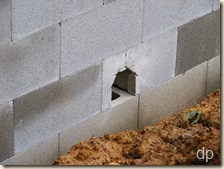 In anticipation of plumbing that I’ll do later, I cut a hole in one block before laying it. This hole will allow me to run the sewer pipe to the septic tank through the wall. I am not completely sure where the septic tank will go at this point. So, I’ll cut another hole on the opposite side of the house, too, just in case I need to place it on that side. I knew I didn’t want to cut a hole later.
In anticipation of plumbing that I’ll do later, I cut a hole in one block before laying it. This hole will allow me to run the sewer pipe to the septic tank through the wall. I am not completely sure where the septic tank will go at this point. So, I’ll cut another hole on the opposite side of the house, too, just in case I need to place it on that side. I knew I didn’t want to cut a hole later.
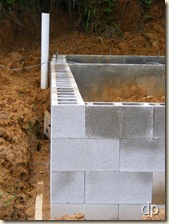 As can be seen in the photo to the left, I didn’t lay out the end wall on the cellar exactly right. It doesn’t line up straight with the crawlspace wall I just laid. I can’t change it, of course, and it really won’t create much problem. I expect that it won’t be very noticeable later anyway.
As can be seen in the photo to the left, I didn’t lay out the end wall on the cellar exactly right. It doesn’t line up straight with the crawlspace wall I just laid. I can’t change it, of course, and it really won’t create much problem. I expect that it won’t be very noticeable later anyway.
A thunder storm rolled through just after I started writing this post. I was planning on working on the front crawlspace wall this afternoon. It may be too muddy now. I’ll see in a little while.
